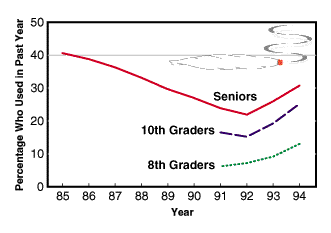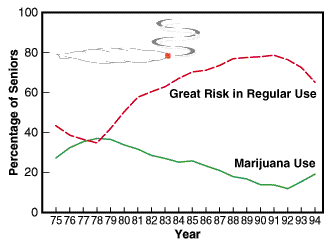 |
News
Volume 10, Number 2
March/April 1995 |
Marijuana, Other Drug Use Among Teens Continues to Rise
By Neil Swan, NIDA NOTES Contributing Writer
The percentage of America's 8th, 10th, and 12th graders who use marijuana continued to increase last year, according to NIDA's 1994 Monitoring the Future study. Students' use of several other categories of drugs also escalated, while antidrug attitudes among teenagers deteriorated, the survey found.
For the third year in a row, the survey reported a statistically significant increase in annual marijuana use by 8th-grade students. Thirteen percent of 8th graders said they had tried marijuana at least once in the past year-up from 9.2 percent in 1993, 7.2 percent in 1992, and 6.2 percent in 1991.
It was the second year in a row that annual marijuana use among 10th- and 12th-grade students increased. Tenth graders' annual marijuana use jumped from 19.2 percent in 1993 to 25.2 percent. According to the annual survey, 30.7 percent of high school seniors said they had tried marijuana at least once in the past year, compared with 26 percent of seniors in 1993 and 21.9 percent of seniors in 1992.
Trends in Adolescents' Annual Use of Marijuana

Annual marijuana use increased for the second year
in a row among 10th and 12th graders and for the third
year in a row among 8th graders
Although the report of increased marijuana use among teenagers, particularly among 8th graders, was the most disturbing survey finding, NIDA Director Dr. Alan I. Leshner pointed out that the 1994 figures remain lower than for most previous years. In 1979, for example, 50.8 percent of 12th graders had tried marijuana in the past year, and every year from 1975 through 1985, the percentage of 12th graders who had smoked marijuana at least once in the year before the survey was more than 40 percent, he said. "Nonetheless, we must recognize that these [current] survey findings are disturbing because they show a continuing trend upward in drug use after a number of years in which that trend was downward," Dr. Leshner said.
"These kids are getting the wrong signal," Dr. Leshner added. "Increasingly, they are viewing drug use as something that is acceptable. We must act decisively to remedy these backsliding attitudes among today's high school students."
Although the 1994 high school survey, which was supported by a NIDA research grant to the University of Michigan's Institute for Social Research, spotlighted increases in marijuana use, students' use of other substances of abuse showed significant increases as well. Other findings include the following:
- Among 8th graders, 25.7 percent acknowledged that they had used illicit drugs at some point in their lives. That figure rose to 35.1 percent when inhalants such as glue or gasoline fumes were included.
- In 1994, 45.6 percent of high school seniors said they had used an illicit drug at least once in their lives. While this is an increase from 42.9 percent of seniors in 1993, it is well below the 65.6 percent of seniors reporting lifetime drug use in the peak year of 1981.
- Annual cocaine use increased among 8th, 10th, and 12th graders for the third year in a row. Among 8th graders, annual use of cocaine has been rising steadily from 1.1 percent in 1991, the first year this age group was surveyed, to 1.5 percent in 1992, 1.7 percent in 1993, and 2.1 percent in 1994. Annual cocaine use for 10th graders climbed from 1.9 percent in 1992 to 2.1 percent in 1993 and 2.8 percent in 1994. Seniors' annual cocaine use rose from 3.1 in 1992 to 3.3 in 1993 and 3.6 percent in 1994.
- The use of crack cocaine increased among 8th graders in 1994. Lifetime crack use rose from 1.7 percent in 1993 to 2.4 percent in 1994, and annual crack use increased from 1 percent to 1.3 percent. Current use of crack, defined as use at least once in the 30 days before the survey, rose from 0.4 percent to 0.7 percent.
- Heroin use also increased among 8th graders. Lifetime use rose from 1.4 percent in 1993 to 2 percent in 1994. Annual use jumped from 0.7 percent to 1.2 percent. Current use increased from 0.4 percent to 0.6 percent.
- More students in all three grades also reported using hallucinogens such as LSD. Annual use of LSD among 10th graders increased from 4.2 percent in 1993 to 5.2 percent in 1994. Increases also occurred in the use of other hallucinogens, a category that includes mescaline, peyote, and PCP, for all grade levels.
- Rates of alcohol use among all three grades remained stable last year. However, alcohol use is still high: 25.5 percent of 8th graders, 39.2 percent of 10th graders, and 50.1 percent of seniors reported having at least one alcoholic drink in the past month.
Marijuana Use vs. Perceived Harm
Trends in Seniors' Past 30-Day Use
and Belief That Regular Use is a Great Risk
 The percentage of students who think that using marijuana
is harmful has declined as marijuana use has increased
The survey also found a broad erosion of antidrug attitudes. The survey revealed a continuing decline in the percentage of students who think using marijuana, cocaine, or crack cocaine is harmful. In 1991, 62.8 percent of 8th graders perceived great risk in trying crack once or twice, but in 1994, only 54.4 percent said they thought trying crack was risky. The percentage of 8th graders in 1994 who associated great risk with trying cocaine powder once or twice or in taking crack and cocaine powder occasionally also dropped. In 1994, fewer students in all three grades said trying marijuana once or twice, smoking marijuana occasionally, or even smoking marijuana regularly is harmful to their health. A decline in the perception of drug use as harmful means that more young people are vulnerable to the use of drugs, said Dr. Leshner.
Health and Human Services (HHS) Secretary Dr. Donna E. Shalala called the findings about increased use of marijuana by 8th graders the most disturbing part of the survey. "Let's not forget," she said, "we're talking about 13-year-olds."
A marijuana prevention initiative aimed at younger audiences is being developed jointly by HHS' drug abuse agencies, including NIDA, Secretary Shalala announced.
From NIDA NOTES, March/April, 1995
[NIDA Home Page][NIDA NOTES Index][1995 Archive Index]
|